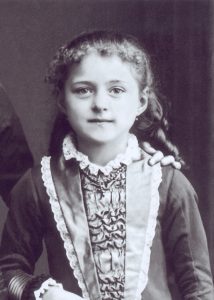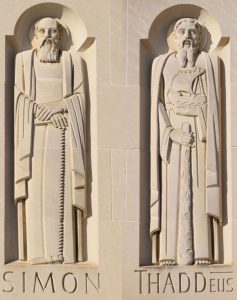
Every October, the Church celebrates many saints with feast days and memorials, honoring their unique contributions to the faith and reflecting on their examples of service. From the woman who wrote The Story of a Soul to the first pope to visit the National Shrine, these saints each have something to teach us. Read about six saints celebrated in October and why you should know their stories.

Saint Thérèse of Lisieux – October 1
Thérèse was born to a watchmaker in the rural town of Alençon, France in 1873. As a child, she was not very social, and at age 15 she joined a Carmelite convent in Lisieux with her sisters. During her time at the convent, she wrote a spiritual guidebook called The Story of a Soul, describing the path to sanctity and offering practical guidelines for holy living, with reflections from her own experience. With millions of copies printed in over 38 languages, this book is now one of the top bestsellers of all time. According to her book, the path to sanctity is facilitated through a constant awareness of God’s presence in all that one does – something she called “the Little Way.” Thérèse carried this character of “littleness” into her own self-perception, viewing herself as an ordinary “Little Flower,” but treasured by God. She saw herself as serving a “vocation of love.” Yet in the face of severe physical suffering, Thérèse displayed faithfulness and devotion that was far from ordinary. Thérèse was plagued by tuberculosis, and the majority of The Story of a Soul was written in the last eighteen months of her life, a time of immense pain for her. She died from tuberculosis on September 30, 1897, and was canonized on May 17, 1925.

Saint Teresa of Avila – October 15
Teresa was born in Ávila, Spain in 1515. Growing up, she and her brother Rodrigo were fascinated with tales of martyrs, and one day tried to run away to Africa in hopes of achieving a similar fate. Luckily, thanks to the intervention of their uncle, they did not get too far – but that zeal for holiness would continue into adulthood. When she was 21, Teresa joined the Carmelite Order in Ávila. She suffered from poor health for most of her life, but that did not stop her from filling her every waking hour with productivity. She oversaw the work of laborers and construction projects at monasteries, and managed relations with royalty and local government. Despite rising as early as five o’clock in the morning for worship, she would often work well past midnight. She founded over thirteen monasteries during her lifetime, many of which functioned as social hubs for the affluent. Teresa was determined to reform these monasteries into more focused institutions, and after years of battling opposition, finally won permission to create a separate province for the reformed order. Teresa is also well-known for her writings – most significantly, The Interior Castle, relating her spiritual insights.
Saint John Paul II – October 22

On May 18 of 1920, Karol Józef Wojtyła was born in Wadowice, Poland. After his time studying at the Jagiellonian University of Krakow was brought to a halt by the Nazi occupation, he began studying at the underground seminary and eventually was ordained in 1946. In 1948, he earned his doctorate in theology, and in the years that followed became a professor of moral theology and ethics in the major seminary of Krakow.
On October 22, 1978, Karol was inaugurated as Pope John Paul II. Less than a year later, on October 7, 1979, he became the first reigning pope to visit the National Shrine. Prior to Saint John Paul II’s papacy, previous popes scarcely travelled outside the confines of the Vatican City State, but he made it his mission to visit the faithful in all parts of the world. Pope Saint John Paul II spread the Gospel to millions of people in over 120 countries during his papacy, earning him the moniker “the Pilgrim Pope.” Through his tireless fight for justice and solidarity, he inspired hope among the politically oppressed and helped bring about the end of the Cold War. He also survived an assassination attempt, making a miraculous recovery after being pierced by two bullets in St. Peter’s Square.
Saint John Paul II had a gift for reaching people of all ages in all places, meeting more individuals than any other pope. His Wednesday General Audiences were attended by over 17.6 million people during his papacy. Saint John Paul II was canonized by Pope Francis on April 27 in 2014.
Saints Simon and Jude – October 28

Celebrated on October 28, Simon and Jude (also known as Judas or Thaddeus) are two of the lesser-known disciples, both of whom are mentioned in the lists of the apostles in Luke 6:14-16 and Acts 1:12-14. We know that they accompanied Jesus on His ministry, and that they were with the rest of the apostles in Jerusalem as they chose Judas Iscariot’s successor and when the Holy Spirit descended.
Simon was known as “the Zealot” which seems to indicate that he was part of a movement in opposition to the government of Rome. This would have put him at the opposite end of the political spectrum from Matthew, who, as a tax collector, was part of the Roman government. Only the love of Christ could unite two men who were so incredibly different.
In Church tradition, Jude is known for performing many miracles, and has a great following as “the saint of the impossible.” He is distinguished from Judas Iscariot with a variety of titles. Luke calls him Judas, son of James. John calls him “Judas (not Iscariot),” and Matthew and Mark call him Thaddeus. (It was typical at the time for Jewish men to have two names.)
Though they are not mentioned often in the Gospel, Simon and Jude still are important biblical figures for their closeness to Jesus and His ministry, and for their involvement in the early Church.
Saint Ignatius of Antioch

Also known as Theophorus, or “Bearer of God,” St. Ignatius was born in Syria in the first century. In 70 A.D., he became the third Bishop of Antioch, and subsequently guided the Church throughout the reigns of multiple emperors, including Domitian, Nerva, and Trajan. When Domitian, who was the first emperor to claim deity, demanded to be called “Lord and God,” Ignatius encouraged the members of the Church to hold fast in refraining from this blasphemous worship. The penalty for such defiance was death.
It wasn’t until the reign of Trajan, however, that the government prosecuted Ignatius for his refusal to join the pagan rites of the state. Convicted for his Christian faith and sentenced to death, Ignatius was sent on a long march to Rome with a group of brutal guards ever near. Yet even as he marched to his execution, Ignatius labored tirelessly to exhort the Church, writing letters to the churches at Ephesus, Magnesia, Tralli, Rome, Philadelphia, and Smyrna along the way. His letters are distinctive in Church history for including the “first surviving written description of the Church as ‘Catholic,’ from the Greek word indicating both universality and fullness.” Once in Rome, he was thrown to the lions in the Flavian Amphitheater and died in 107. You can find him portrayed in the Basilica in the Eastern Façade.

